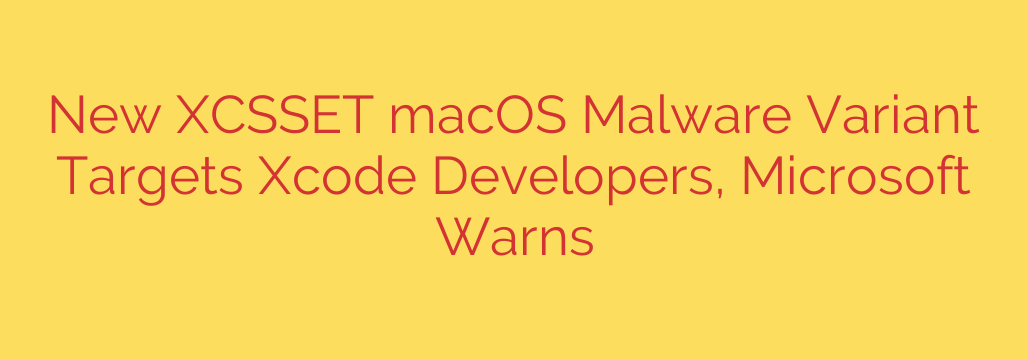
macOS Developers Beware: A New XCSSET Malware Variant is Hiding in Xcode Projects
A sophisticated and dangerous new strain of malware is actively targeting macOS developers, leveraging their own tools against them in a classic supply chain attack. Security researchers have identified an evolved variant of the XCSSET malware, which specifically infects Xcode projects to gain a foothold on developers’ systems, steal sensitive information, and compromise downstream users.
This threat underscores a critical vulnerability within the development ecosystem, where trust in shared code can be exploited with devastating consequences. All developers working on macOS should be aware of how this malware operates and take immediate steps to secure their environments.
How the XCSSET Malware Attack Works
The core of the attack lies in its deceptive distribution method. The malware spreads by injecting malicious code into local Xcode projects on a developer’s machine. When these compromised projects are shared, typically through public repositories on platforms like GitHub, other unsuspecting developers can download and use them.
Here’s a breakdown of the infection process:
- Initial Infection: A developer downloads a trojanized Xcode project from an untrusted source.
- Execution on Build: When the developer builds the project in Xcode, the hidden malicious code is compiled and executed. This is particularly insidious because it leverages a routine, necessary part of the development workflow.
- Persistence and Propagation: Once active, the malware searches the system for other Xcode projects and injects its malicious payload into them, continuing the cycle of infection.
The primary danger of XCSSET is its extensive data-stealing capabilities. Once it has compromised a system, it can perform a range of malicious actions designed to harvest valuable information.
Key Capabilities and Dangers of the New Variant
This latest version of XCSSET is a significant threat due to its advanced features. Security analysts have observed that the malware is designed to:
- Steal Sensitive Browser Cookies: The malware specifically targets browsers like Safari and Chrome to exfiltrate session cookies. This allows attackers to bypass two-factor authentication and hijack active login sessions for critical services, including cryptocurrency exchanges, social media accounts, and corporate email.
- Capture Credentials from Apps: It has the ability to steal data and credentials from popular applications installed on the system, such as Telegram, Notes, and Skype.
- Deploy Ransomware: In some cases, the malware can be used as a dropper to download and execute ransomware, encrypting a victim’s files and demanding payment.
- Inject Malicious JavaScript: XCSSET can inject malicious JavaScript into websites the user is visiting. This can be used for session hijacking, displaying phishing pages, or modifying web content without the user’s knowledge.
- Take Screenshots: The malware can capture screenshots of the user’s desktop, potentially exposing confidential business data, personal information, or private conversations.
This method represents a potent supply chain attack. By compromising a single developer’s machine, attackers can infect numerous other projects, effectively poisoning the well for anyone who uses that developer’s code.
How to Protect Your Mac and Development Environment
Given the stealthy nature of this threat, developers must adopt a security-first mindset. Standard macOS protections may not be enough to stop an attack that originates from a trusted development tool like Xcode.
Here are actionable steps to secure your system against XCSSET and similar threats:
- Scrutinize Your Sources: Only download Xcode projects from official and highly reputable repositories. Be extremely cautious when cloning projects from unknown or unverified GitHub accounts. Check for signs of legitimacy, such as community engagement, recent updates, and a credible author history.
- Vet Your Dependencies and Scripts: Before building a new project, carefully inspect its contents. Pay close attention to unusual or obfuscated shell scripts, especially those configured to run during the build process. Malicious code is often hidden within these build phase scripts.
- Implement Endpoint Security: Use a reputable endpoint detection and response (EDR) or next-generation antivirus (NGAV) solution designed for macOS. These tools can often detect malicious behavior and unauthorized file modifications that traditional antivirus might miss.
- Isolate Development Environments: Whenever possible, consider using virtual machines or containers for testing un-trusted code. This can help contain any potential infection and prevent it from spreading to your primary system.
- Update Everything: Ensure your macOS, Xcode, and all development tools are kept fully updated. Software updates frequently contain critical security patches that can protect you from known vulnerabilities.
The emergence of this advanced XCSSET variant is a stark reminder that the macOS platform is a valuable target for cybercriminals. Developers, who hold the keys to vast software ecosystems, must remain vigilant and proactive in their security practices to protect not only their own data but the integrity of the entire software supply chain.
Source: https://www.bleepingcomputer.com/news/security/microsoft-warns-of-new-xcsset-macos-malware-variant-targeting-xcode-devs/








